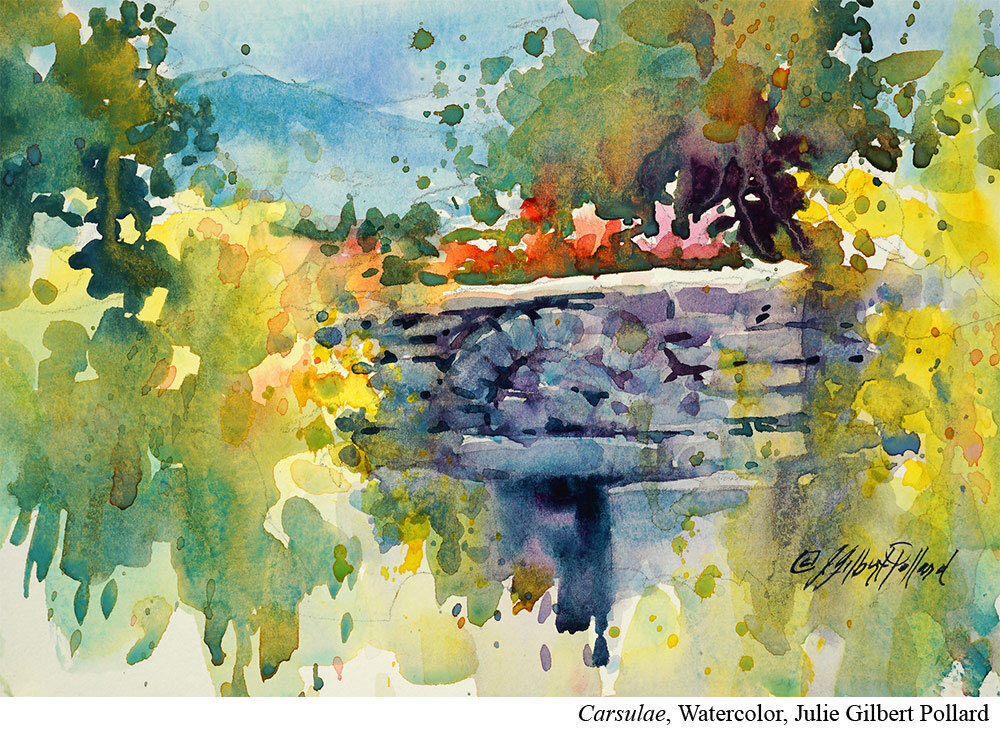Four Ways You Get Mud In Watercolor (And How to Avoid Them)
When it comes to learning to paint watercolor, every artist will have to eventually face mud.
“If you look at a watercolor and it looks muddy, it looks muddy,” says watercolorist Julie Gilbert Pollard (Ep. 25).
Mud may be a nemesis of the medium, but Pollard says that if you can learn where they happen, you can also learn how to avoid them.
In this article, we will first look at the 4 places where Pollard says mud is most likely to happen in your watercolor painting and then the three ways to avoid creating mud.
WHERE CAN MUD HAPPEN IN WATERCOLOR?
Palette Mixing Mud
Artists can mix mud in their palette. Some watercolor paints just don’t work well together either because of color mixtures gone awry or the paints physical properties don’t like each other.
However, Pollard dismisses the idea that there’s any rule to how many colors you’re limited to mixing before the mud appears.
“If you know how to mix color, you can mix a whole bunch of colors together and it still won't look like mud if you understand color.”
Pollard is careful to point out that this is different from mixing neutrals. If you mix two complementary colors together, red and green for example, you might mix a lovely neutralized color.
The more you paint, you’ll learn which colors mix to create neutrals and which colors mix to create mud.
But if you do see mud in your palette...great work! You’ve caught it early enough to avoid it. Stop, wipe the palette clean and start again. (And maybe make a note of what colors you combined so you can avoid it going forward.)
Paper Mixing Mud
As with palette mixing, if you are working wet into wet, you are mixing colors on the paper. Anytime colors mix, mud can make an appearance. Similarly to palette mud, this is about being aware of what color combinations work in watercolor and which don’t. Artists often refer to this as colors playing nicely with each other. And in watercolor, some just don’t.
Pollard suggests making notes to yourself about which colors mix in a pleasing manner. It’s too much information, especially when you’re first learning to paint, to keep it all in your head.
Mud may also more likely appear when you’re still learning moisture control. Pollard, for example, can start with a pink passage of paint and move into a green passage of paint with very little risk of creating mud (or even much neutralization) because she understands the correct moisture to pigment ratio she needs to keep the colors rippling back into each other.
Glazing Mud
There are two types of color mixing. Physical mixing is when you physically combine the paints either on your palette or on your paper. But there’s a second way: optical mixing.
In watercolor you have the option to glaze, which is optical mixing. Glazing is where you place thin washes of paint over previous dried layers. When you place a glaze of yellow over blue, for example, they will mix optically and you will be left with a green.
“If you know how to mix color, you can mix a whole bunch of colors together and it still won't look like mud if you understand color.”
-Julie Gilbert Pollard
This is one of watercolor’s strengths. It is also one of watercolor’s challenges because it’s another opportunity to accidentally create mud. If you layer too many colors that don’t work well together then you may get optically mixed mud.
So again, take notes of what is working and what isn’t. It’s all knowledge you can use for your next painting.
Grade of Paint Mud
There is a fourth way to get mud.
Professional grade paints can make mud. That’s true. But you may struggle with it more with lower grade paints. The physical attributes of the paint (like granulation size of pigment and amount of filler used) affect the potential mud.
HOW DO I AVOID MUD IN A WATERCOLOR PAINTING
So now that you understand the types of mud, how do you avoid mud in your watercolor paintings?
First, invest in some high quality artist grade paints. If cost is an issue, wait for them to go on sale and work with a limited palette.
Second, pay attention to what is working and what isn’t working in your paintings and studies. Keep a color log about which physical mixtures and optical mixtures were successes and which were not. You’ll build up a color knowledge library from which to draw.
Third, practice practice practice. The more you paint, the more confidence and skill you’ll develop. You’ll start to have instincts about which color combinations create mud and which create glowing passages. You’ll also get better at moisture control and so when you place a brush stroke of one color down, you’ll have a better sense of how it will interact with the paint already on the page.
OVERCOMING MUD
Mud can be a frustrating part of learning to paint watercolor. But if you start noticing where it’s happening and learning why it does, you’ll soon be on your way to glowing, mud free watercolor paintings.



